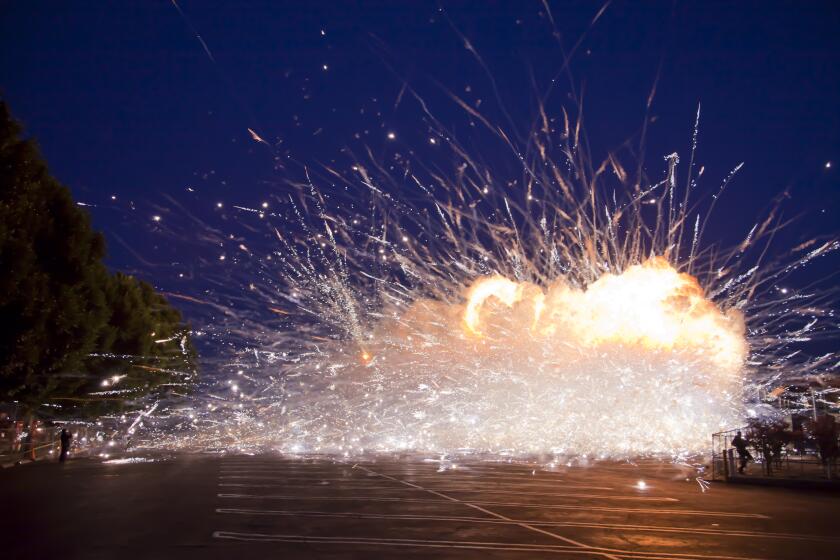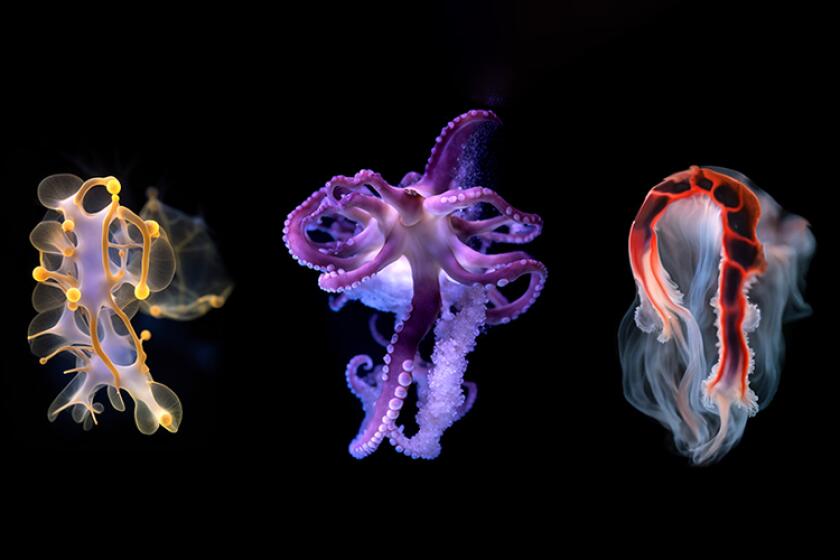LACMA opening pushed to 2026; staff memo reveals plans for sneak peek inside empty new building

- Share via
Sometime next year, we might have an opportunity for a sneak peek inside the David Geffen Galleries, the new permanent collection building under construction on the Los Angeles County Museum of Art’s Wilshire Boulevard campus.
A recent staff memo obtained by The Times reveals the possibility for a public glimpse inside the poured-concrete and glass building prior to the installation of art. The memo is a general planning update from J. Fiona Ragheb, LACMA deputy director of curatorial and exhibitions, the museum official charged with overseeing the project.
May 28, 2025, is the target date for LACMA to receive a temporary certificate of occupancy — a TCO — which grants use of a building before completion of all construction work, as long as safety criteria are met. Following lengthy pandemic and other delays, the museum had said construction of the $750-million facility would be finished this December. But summer looks to be the best bet now, with a finished building filled with art premiering in 2026.
The world just experienced its hottest year on record, but does our climate crisis make for good art? With the latest iteration of Pacific Standard Time, we’ll soon find out.
The update memo includes design initiatives both major and minor, none of which the tight-lipped museum has revealed before. Most noteworthy: LACMA is brainstorming public programs to take place in the empty building, once “full TCO” status is secured.
Don’t expect to see the long-shuttered permanent collection of paintings, sculptures, drawings and other works of art, which are the reason the place exists. The rooms will be mostly empty. The as-yet-undetermined events would allow visitors to see inside the glass-walled Geffen Galleries, designed by Swiss architect Peter Zumthor and spanning Wilshire on piers, potentially for as long as two weeks prior to the start of a prolonged process of collection installation.
The labor-intensive installation process will continue into 2026. (The initial timeline had the new museum opening in 2023.) LACMA’s Ragheb wrote in her email to colleagues, “Once the building is turned over, we are imagining a short period (10-14 days) that will be reserved for programming that takes advantage of this once in a lifetime opportunity to work with the empty building.”
Absent the art, Zumthor’s curvilinear sculptural construction of poured concrete is plainly being advanced as an art object in its own right, independent of its museum function. The architect, 81, is expected to arrive in Los Angeles Oct. 15 to review the project’s progress.
The latest installment of Pacific Standard Time, the museum series that this year is titled ‘PST Art: Art & Science collide,’ has arrived. Here’s our shortlist of exhibitions and events.
The staff memo also describes a novel gallery layout for the permanent collection, which includes textiles and costumes, photographs, prints, drawings, decorative and other works of art, in addition to paintings and sculptures. Changing thematic exhibitions will be presented in areas designated as “oceans,” which pointedly scraps typical museum categories of continent, nation, empire or time period. The Atlantic and Pacific each will have two areas, presumably referring to the northern and southern hemispheres, while a fifth is named for the Indian Ocean. A sixth portion is identified for the Mediterranean, which is technically a sea.
The entire collection, which numbers more than 150,000 objects from 6,000 years of global artistic expression, was moved by mid-2019 to Southland storage facilities. Going forward, most of it will remain stored in far-flung locales across Los Angeles and Orange counties.
Collection installation will signal the conclusion of more than a seven-year hiatus from public view. During that lengthy period, a few things have been lent to other museums or sent on tour.
Maruyama Ōkyo’s “Cranes,” a masterpiece of 18th century Japanese screen painting, plus an unfinished Mannerist altarpiece of the Virgin Mary by 16th century Florentine painter Rosso Fiorentino, are among notable individual works loaned locally to the J. Paul Getty Museum. A summer exhibition of more than 100 works drawn from LACMA’s important collection of Spanish colonial art, which has largely been formed in the last 15 years, closed Sept. 1 at the St. Louis Art Museum.
That collection show was presented in LACMA’s Resnick Pavilion two years ago, and it suggests future travel prospects. News broke last December that LACMA was entering a collection-loan partnership with the new Las Vegas Museum of Art. The Vegas project, on the drawing board to be built near downtown’s Glitter Gulch, won’t have its own art collection, so expect LACMA’s oceanic theme displays from the Geffen to be packaged for regular travel to Nevada.
The Norton Simon in Pasadena may get overshadowed by LACMA, MOCA and the Broad, but its 12,000-piece collection is one of SoCal’s best. Our critic offers a shortlist of don’t-miss works.
Ragheb, who is both an art historian and a licensed architect, did not immediately respond to a request for comment. Her memo notes ongoing deliberations over minimalist designs for steel-and-glass casework and vitrines; donor signage that will include some names chiseled into concrete walls; more profuse didactic wall texts than originally envisioned; a bespoke color palette featuring all-natural architectural pigments (the chosen company, Alkemis, bills its plastics-free product as “wellness paint”); and further necessary steps toward finishing the job.
Other knowledgeable sources, who are not authorized to speak publicly, have told me that, in-house, the budget figure being used for complete project expenses is upwards of $835 million. Considerably bigger than the publicized $750-million budget, the larger figure includes essential outlays for the casework, extensive landscaping, furniture, perimeter curtains for light control in galleries, a year-long art collection installation process and other elements that are not part of the Zumthor building’s hard construction costs.
Also being contemplated is a dedicated gallery for European paintings and sculptures donated by the Ahmanson Foundation, which severed its five-decade partnership with LACMA in 2020 over disagreements with the Zumthor plan. Past Ahmanson gifts to the museum include exceptional examples by Gian Lorenzo Bernini, Georges de La Tour, Jean-Antoine Houdon and Jacques-Louis David.
Foundation President William H. Ahmanson remains a museum trustee. But, since the split, the foundation has been acquiring paintings for the Huntington Library, Art Museum, and Botanical Gardens in San Marino, including significant canvases by Francisco Goya, Thomas Cole, Élisabeth Vigée Le Brun and, announced just two weeks ago, the less well-known Antoine-François Callet, court painter to Louis XVI. LACMA’s original 1965 permanent collection facility was the Ahmanson Building, torn down four years ago to make way for the new David Geffen Galleries. A dedicated room for Ahmanson’s donated art now would seem to be a gesture, however modest, toward restoring the broken relationship.
More to Read
The biggest entertainment stories
Get our big stories about Hollywood, film, television, music, arts, culture and more right in your inbox as soon as they publish.
You may occasionally receive promotional content from the Los Angeles Times.














